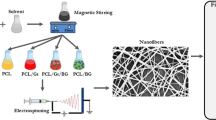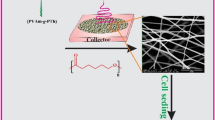Abstract
Considering the well-known phenomenon of enhancing bone healing by applying electromagnetic stimulation, manufacturing conductive bone scaffolds is on demand to facilitate the delivery of electromagnetic stimulation to the injured region, which in turn significantly expedites the healing procedure in tissue engineering methods. For this purpose, hybrid conductive scaffolds composed of poly(3,4-ethylenedioxythiophene), poly(4-styrene sulfonate) (PEDOT:PSS), gelatin (Gel), and bioactive glass (BaG) were produced employing freeze drying technique. Concentration of PEDOT:PSS were optimized to design the most appropriate conductive scaffold in terms of biocompatibility and cell proliferation. More specifically, scaffolds with four different compositions of 0, 0.1, 0.3 and 0.6 % (w/w) PEDOT:PSS in the mixture of 10 % (w/v) Gel and 30 % (w/v) BaG were synthesized. Immersing the scaffolds in simulated body fluid (SBF), we evaluated the bioactivity of samples, and the biomineralization were studied in details using scanning electron microscopy, energy dispersive spectroscopy, X-ray diffraction analysis and Fourier transform infrared spectroscopy. By performing cytocompatibility analyses for 21 days using adult human mesenchymal stem cells, we concluded that the scaffolds with 0.3 % (w/w) PEDOT:PSS and conductivity of 170 μS/m has the optimized composition and further increasing the PEDOT:PSS content has inverse effect on cell proliferation. Based on our finding, addition of this optimized amount of PEDOT:PSS to our composition can increase the cell viability more than 4 times compared to a nonconductive composition.






Similar content being viewed by others
References
Yazdimamaghani M, Vashaee D, Assefa S, Walker K, Madihally S, Köhler G, et al. Hybrid macroporous gelatin/bioactive-glass/nanosilver scaffolds with controlled degradation behavior and antimicrobial activity for bone tissue engineering. J Biomed Nanotechnol. 2014;10:911–31.
Yazdimamaghani M, Razavi M, Vashaee D, Tayebi L. Microstructural and mechanical study of PCL coated Mg scaffolds. Surf Eng. 2014;30:920–926.
Razavi M, Fathi M, Savabi O, Beni BH, Vashaee D, Tayebi L. Surface microstructure and in vitro analysis of nanostructured akermanite (Ca2MgSi2O7) coating on biodegradable magnesium alloy for biomedical applications. Colloids Surf B. 2014;117:432–40.
Razavi M, Fathi MH, Savabi O, Vashaee D, Tayebi L. Biodegradation, bioactivity and in vivo biocompatibility analysis of plasma electrolytic oxidized (PEO) biodegradable Mg implants. Phys Sci Int J. 2014;4:708.
Bendrea AD, Cianga L, Cianga I. Review paper: progress in the field of conducting polymers for tissue engineering applications. J Biomater Appl. 2011;26:3–84.
De Giglio E, Sabbatini L, Colucci S, Zambonin G. Synthesis, analytical characterization, and osteoblast adhesion properties on RGD-grafted polypyrrole coatings on titanium substrates. J Biomater Sci-Polym Ed. 2000;11:1073–83.
Mozafari M, Salahinejad E, Shabafrooz V, Yazdimamaghani M, Vashaee D, Tayebi L. Multilayer bioactive glass/zirconium titanate thin films in bone tissue engineering and regenerative dentistry. Int J Nanomed. 2013;8:1665.
Tahmasbi Rad A, Ali N, Kotturi HSR, Yazdimamaghani M, Smay J, Vashaee D, et al. Conducting scaffolds for liver tissue engineering. J Biomed Mater Res A. 2014;102(11):4169–81.
Shahini A, Yazdimamaghani M, Walker K, Eastman M, Hatami-Marbini H, Smith B, et al. 3D conductive nanocomposite scaffold for bone tissue engineering. Int J Nanomed. 2014;9:167–81.
Kotwal A, Schmidt CE. Electrical stimulation alters protein adsorption and nerve cell interactions with electrically conducting biomaterials. Biomaterials. 2001;22:1055–64.
Bolin MH, Svennersten K, Wang XJ, Chronakis IS, Richter-Dahlfors A, Jager EWH, et al. Nano-fiber scaffold electrodes based on PEDOT for cell stimulation. Sens Actuator B-Chem. 2009;142:451–6.
Guimard NK, Gomez N, Schmidt CE. Conducting polymers in biomedical engineering. Prog Polym Sci. 2007;32:876–921.
Miklavčič D, Pavšelj N, Hart FX. Electric properties of tissues. Wiley encyclopedia of biomedical engineering; 2006.
Richardson-Burns SM, Hendricks JL, Foster B, Povlich LK, Kim D-H, Martin DC. Polymerization of the conducting polymer poly(3,4-ethylenedioxythiophene)(PEDOT) around living neural cells. Biomaterials. 2007;28:1539–52.
Luo S-C, Mohamed Ali E, Tansil NC, Yu H-h, Gao S, Kantchev EA, et al. Poly(3,4-ethylenedioxythiophene)(PEDOT) nanobiointerfaces: thin, ultrasmooth, and functionalized PEDOT films with in vitro and in vivo biocompatibility. Langmuir. 2008;24:8071–7.
Karagkiozaki V, Karagiannidis P, Gioti M, Kavatzikidou P, Georgiou D, Georgaraki E, et al. Bioelectronics meets nanomedicine for cardiovascular implants: PEDOT-based nanocoatings for tissue regeneration. Biochim Biophys Acta. 2013;1830:4294–304.
Kim DR, Abidian M, Martin D. Synthesis and characterization of conducting polymers grown in hydrogels for neural applications. In: Proceedings of the symposium on architecture and application of biomaterials and biomolecular materials, Boston, MA, 2003. p. 1–4.
Xiao X, Liu R, Liu F, Zheng X, Zhu D. Effect of poly(sodium 4-styrene-sulfonate) on the crystal growth of hydroxyapatite prepared by hydrothermal method. Mater Chem Phys. 2010;120:603–7.
Crispin X, Marciniak S, Osikowicz W, Zotti G, Van der Gon AWD, Louwet F, et al. Conductivity, morphology, interfacial chemistry, and stability of poly(3,4-ethylene dioxythiophene)-poly(styrene sulfonate): a photoelectron spectroscopy study. J Polym Sci Pt B-Polym Phys. 2003;41:2561–83.
Friedel B, Keivanidis PE, Brenner TJK, Abrusci A, McNeill CR, Friend RH, et al. Effects of layer thickness and annealing of PEDOT:PSS layers in organic photodetectors. Macromolecules. 2009;42:6741–7.
Hwang J, Amy F, Kahn A. Spectroscopic study on sputtered PEDOT center dot PSS: role of surface PSS layer. Org Electron. 2006;7:387–96.
Choi YS, Hong SR, Lee YM, Song KW, Park MH, Nam YS. Study on gelatin-containing artificial skin: I. Preparation and characteristics of novel gelatin-alginate sponge. Biomaterials 1999;20:409–17.
Ghasemi-Mobarakeh L, Prabhakaran MP, Morshed M, Nasr-Esfahani M-H, Ramakrishna S. Electrospun poly(ɛ-caprolactone)/gelatin nanofibrous scaffolds for nerve tissue engineering. Biomaterials. 2008;29:4532–9.
Yazdimamaghani M, Vashaee D, Assefa S, Shabrangharehdasht M, Rad AT, Eastman MA, et al. Green synthesis of a new gelatin-based antimicrobial scaffold for tissue engineering. Mater Sci Eng C. 2014;39:235–44.
Jones JR. Review of bioactive glass: from Hench to hybrids. Acta Biomater. 2013;9:4457–86.
Yazdimamaghani M, Razavi M, Vashaee D, Pothineni VR, Rajadas J, Tayebi L. Significant degradability enhancement in multilayer coating of polycaprolactone-bioactive glass/gelatin-bioactive glass on magnesium scaffold for tissue engineering applications. Appl Surf Sci. 2015;338:137–45.
Kokubo T, Takadama H. How useful is SBF in predicting in vivo bone bioactivity? Biomaterials. 2006;27:2907–15.
Jones JR, Ehrenfried LM, Hench LL. Optimising bioactive glass scaffolds for bone tissue engineering. Biomaterials. 2006;27:964–73.
Fassina L, Saino E, Sbarra MS, Visai L, De Angelis MGC, Magenes G, et al. In vitro electromagnetically stimulated SAOS-2 osteoblasts inside porous hydroxyapatite. J Biomed Mater Res A. 2010;93:1272–9.
Sun S, Titushkin I, Cho M. Regulation of mesenchymal stem cell adhesion and orientation in 3D collagen scaffold by electrical stimulus. Bioelectrochemistry. 2006;69:133–41.
Lee K, Park M, Kim H, Lim Y, Chun H, Kim H, et al. Ceramic bioactivity: progresses, challenges and perspectives. Biomed Mater. 2006;1:R31.
Kim H-M. Ceramic bioactivity and related biomimetic strategy. Curr Opin Solid State Mater Sci. 2003;7:289–99.
Hench LL, Xynos ID, Polak JM. Bioactive glasses for in situ tissue regeneration. J Biomater Sci Polym Ed. 2004;15:543–62.
Hronik-Tupaj M, Kaplan DL. A review of the responses of two-and three-dimensional engineered tissues to electric fields. Tissue Eng B: Rev. 2012;18:167–80.
Darendeliler MA, Darendeliler A, Sinclair PM. Effects of static magnetic and pulsed electromagnetic fields on bone healing. Int J Adult Orthod Orthognath Surg. 1997;12:43–53.
Shupak NM, Prato FS, Thomas AW. Therapeutic uses of pulsed magnetic-field exposure, a review. Radio Sci Bull 2003;307:9–32.
Meng SY, Zhang Z, Rouabhia M. Accelerated osteoblast mineralization on a conductive substrate by multiple electrical stimulation. J Bone Miner Metab. 2011;29:535–44.
Ryaby JT. Clinical effects of electromagnetic and electric fields on fracture healing. Clin Orthop Relat Res. 1998;355:S205–15.
Shiyun Meng MR, Ze Zhang. Electrical stimulation in tissue regeneration. INTECH Open Access Publisher, 2011.
Tabrah F, Hoffmeier M, Gilbert F, Batkin S, Bassett CAL. Bone-density changes in osteoporosis-prone women exposed to pulsed electromagnetic-fields (PEMFS). J Bone Miner Res. 1990;5:437–42.
Tandon N, Goh B, Marsano A, Chao P-H, Montouri-Sorrentino C, Gimble J, et al. Alignment and elongation of human adipose-derived stem cells in response to direct-current electrical stimulation. Engineering in medicine and biology society, 2009 EMBC 2009 annual international conference of the IEEE: IEEE; 2009. p. 6517–21.
Li XF, Kolega J. Effects of direct current electric fields on cell migration and actin filament distribution in bovine vascular endothelial cells. J Vasc Res. 2002;39:391–404.
Author information
Authors and Affiliations
Corresponding author
Additional information
Mostafa Yazdimamaghani and Mehdi Razavi contributed equally to this work.
Rights and permissions
About this article
Cite this article
Yazdimamaghani, M., Razavi, M., Mozafari, M. et al. Biomineralization and biocompatibility studies of bone conductive scaffolds containing poly(3,4-ethylenedioxythiophene):poly(4-styrene sulfonate) (PEDOT:PSS). J Mater Sci: Mater Med 26, 274 (2015). https://doi.org/10.1007/s10856-015-5599-8
Received:
Accepted:
Published:
DOI: https://doi.org/10.1007/s10856-015-5599-8




